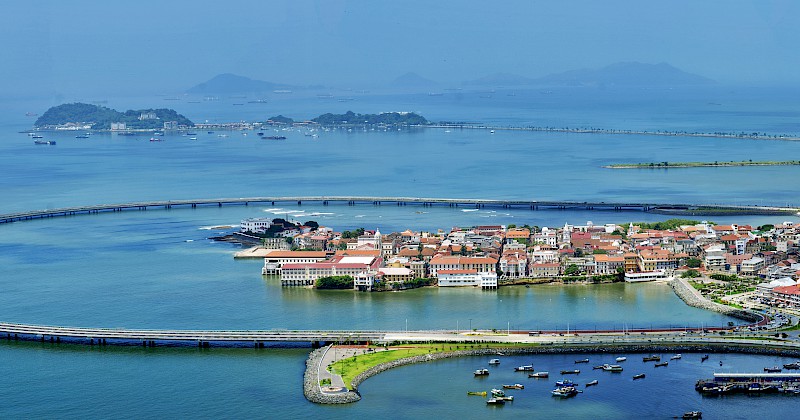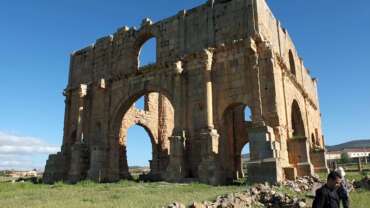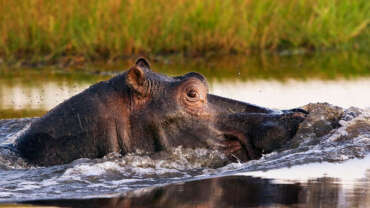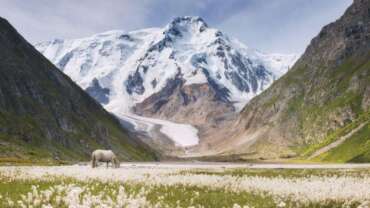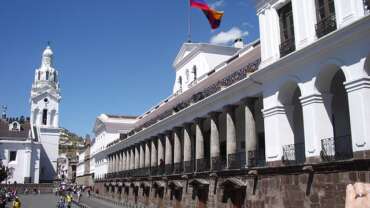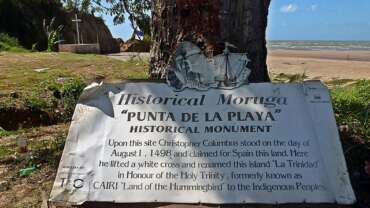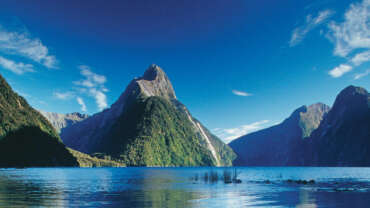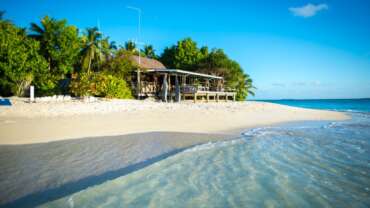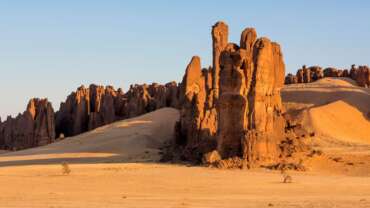Panama - not for tourists!
MEET THE COUNTRY THAT EMERGED FROM THE SEA TO CHANGE THE WORLD FOREVER.
Panama is a country on the isthmus linking Central and South America. The Panama Canal, a famous feat of human engineering, cuts through its center, linking the Atlantic and Pacific oceans to create an essential shipping route. In the capital, Panama City, modern skyscrapers, casinos and nightclubs contrast with colonial buildings in the Casco Viejo district and the rainforest of Natural Metropolitan Park.
History of Panama
Exploration, conquest, and settlement
In 1501 the Spaniard Rodrigo de Bastidas, in the company of Juan de la Cosa and Vasco Núñez de Balboa, was the first European to explore the Atlantic coast of the Isthmus of Panama. In 1510 Diego de Nicuesa, another Spanish explorer, established the settlement of Nombre de Dios at the mouth of the Chagres River, and to the southwest, Alonso de Ojeda founded San Sebastian de Urabá. The colony, facing fierce resistance from local Indian tribes, was moved at the instigation of Balboa. The new site was to the northeast, across the Atrato River, and was named Santa María de la Antigua del Darién. It became the first permanent settlement on the isthmus and the focus of jealous intrigues centring around Balboa.
As head of the colony, Balboa, by the use of persuasion and force, brought most of the Indians under submission. Some of them revealed to him that a large sea and a gold-rich empire existed to the south, which perhaps was that of the Inca. In September 1513, Balboa reached the sea and claimed the Pacific Ocean for his king. Returning to Santa María in January 1514, he encountered much resistance from the Indians. Five years afterward Balboa was executed for insurrection on orders of the new governor, Pedro Arias de Ávila, known as Pedrarias Dávila, “the Cruel,” who had distrusted Balboa and feared his rivalry.
In 1519 the population of Santa María moved to the new town of Panama (the first European settlement on the west coast of the hemisphere), which became the centre of commercial activity and the springboard for the conquest of Peru. The colony became an important part of Spain’s mercantile system, attaining the rank of audiencia in 1538. Nombre de Dios, which was resettled and linked to Panama town by road, was renowned for its ferias (grand markets, or trade fairs). With the final destruction of Nombre de Dios in the late 16th century by the Englishman Francis Drake, commercial activity was moved to the hamlet of Portobelo, overlooking the calm bay recorded by Christopher Columbus in 1502. Portobelo then became a centre of Spanish commerce in the New World and the site of great ferias.
Panama town and Portobelo continued to attract the attention of English raiders, however, and disastrous consequences befell both settlements. Henry Morgan destroyed Panama town in 1671, and Admiral Edward Vernon razed Portobelo in 1739. In the year of Vernon’s raid, the colony was reduced in status when Spain abolished the Audiencia of Panama and placed its territory within the Viceroyalty of New Granada. Portobelo was rebuilt in 1751, but by then the Spanish galleons had begun to use the route around Cape Horn, accelerating the city’s decline through loss of trade. In 1673 the town of Panama was rebuilt a few miles west of the old town. By 1793 it was the principal town on the isthmus, with more than one-tenth of Panama’s civilian population of 71,888.
Secession from Spain and union with Gran Colombia
As the agitation for independence grew elsewhere in Spanish America, Panama, dependent on seaborne trade and relatively isolated from mutinous colonies, did not join the insurrection. The viceroy moved his headquarters from Quito (now in Ecuador) to Panama town, which sent deputies to the Cortes (parliament) in Cádiz, Spain, during the Napoleonic Wars. When the Spanish merchants secured the revocation of the royal decree authorizing foreign trade, Panama changed sides. In the autumn of 1821 the colony seceded from Spain and joined the Gran Colombia union. For a time Panama enjoyed the right to elect its own governor, but in 1843 a new constitution returned that power to officials in Bogotá. Soon afterward Panama became a state within Colombia and, despite numerous efforts to break away, remained so for the rest of the century.
Transcontinental railroad and canal projects
In 1847 the Colombian government negotiated the building of a transcontinental railroad by investors in the United States, but political and health problems kept it from becoming operational until 1855. The Bidlack-Mallarino Treaty of 1846 had granted the United States a right-of-way through the isthmus and thus the right to intervene to protect the line and free transit across the continent. Political turmoil raged while construction was under way. Panama inaugurated and discarded 20 governors (also called presidents), while New Granada (now Colombia) elected, substituted, or deposed 7 in Bogotá.
The railroad helped the gold rushers destined for California, U.S., after 1848, but it also encouraged canal planners. Ultimately Colombia awarded the rights to build the canal to the French diplomat Ferdinand de Lesseps (who had been instrumental in building the Suez Canal in Egypt) and his Universal Interocean Canal Company; construction began in 1880. By 1889 disease, chicanery, and financial scandals in France and Bogotá ruined the corporation.
By 1892 Philippe Bunau-Varilla, a French former chief engineer of the canal works, had formed a new canal company, which acquired the assets of the defunct one. After considerable debate, the United States decided to build a canal through Panama rather than Nicaragua, and the U.S. Congress’s Spooner Act of 1902 authorized the U.S. president to buy the assets of the French company. Following up on this, Bunau-Varilla pressured Colombia to negotiate the Hay-Herrán Treaty of 1903, which would have allowed the United States to control a strip of land surrounding the projected canal. The Colombian senate, however, rejected the treaty.
Bunau-Varilla then turned to a group of Panamanian revolutionaries who were uniting in opposition to the Colombian government’s rejection of the canal treaty, its requisitions of property, and its impressment of Panamanian men during a civil war. On November 3, 1903, a revolutionary junta proclaimed Panamanian independence. Colombian forces were sent to crush the rebellion, but they were mired at Colón because the U.S.-administered railroad had strategically removed its trains from the northern terminus. U.S. naval forces also deterred reinforcements that were sent from Bogotá by land. The secessionist junta appointed Bunau-Varilla minister to Washington, D.C., with full powers to negotiate treaties. On November 18, 1903, he and U.S. Secretary of State John Hay signed the Hay–Bunau-Varilla Treaty. By this treaty the United States obtained, in perpetuity, the exclusive use, occupation, and control of the Canal Zone, a strip 10 miles (16 km) wide (5 miles on each side of the waterway). Formal acquisition of the lands took place on May 4, 1904. Construction of the canal resumed that summer, and it was opened on August 15, 1914.
The Republic of Panama
Early years
The new constitution authorized the United States to intervene militarily in Panama in order to quell disturbances. It also provided for a centralized government headed by a president who had the authority to appoint and dismiss provincial governors. Manuel Amador Guerrero became the first president, and universal suffrage was adopted in June 1907. As had been the case under Colombian government, traditional Liberal and Conservative parties dominated politics, but personalities and family ties proved more important than ideology in most contests. Political and economic unrest brought bloodless military interventions by the United States in 1908, 1912, 1918, and 1925.
In January 1931 the government of Florencio Harmodio Arosemena was overthrown in a bloody coup led by Arnulfo Arias Madrid, a charismatic populist unconnected to the traditional political elites. The United States acquiesced and promptly recognized as president the minister to Washington, Ricardo Alfaro, who presided over orderly elections in 1932, when Harmodio Arias Madrid (brother of Arnulfo) was the winner.
The new president persuaded the United States to relinquish its rights of intervention and of seizing lands for canal-related purposes, and the Hay–Bunau-Varilla Treaty was thus modified in 1936 by the Hull-Alfaro Treaty. In addition, the United States increased the annuity paid for the use of the Canal Zone and agreed to build a transisthmian highway. The Arias brothers soon fell out, however, and Arnulfo began his own quest for the presidency, which he won in June 1940. He then changed the constitution to extend the length of his term.
World War II and mid-century intrigues
Before the United States became embroiled in World War II, it requested defense sites outside the Canal Zone for landing fields, roads, antiaircraft batteries, and warning stations. Arias, who openly sympathized with fascism, demanded compensation in the form of cash and the transfer to Panama of various properties. While in Havana, Cuba, on a private visit, he was removed from office by the national police (Panama had no army) in October 1941, and Ricardo Adolfo de la Guardia became president. After the Japanese attack on Pearl Harbor, Hawaii, on December 7, 1941, Panama transferred the defense sites to the United States, and tens of thousands of U.S. troops were stationed there to guarantee the security of the canal. While the waterway was never actually attacked, Japan had planned to do so, intending to use aircraft launched from submarines; however, the war ended before this effort could be mounted.
During and after the war the United States eventually returned 98 defense sites to Panama but continued negotiations on 36 others. The Panamanian government finally agreed to lease the sites, but the Panamanian National Assembly, influenced by the threat of mob violence, rejected the proposals. The United States abandoned the additional bases in 1947.
In 1945 the National Assembly put an end to the regime of de la Guardia, sent him into exile, and selected the ambassador to Washington, Enrique A. Jiménez, as president. In the presidential elections of 1948 Domingo Díaz Arosemena was declared the winner by the National Jury of Elections, depriving Arnulfo Arias of a victory. Díaz died in office in 1949, and, under a mountain of popular protests, his two vice presidents first accepted and then refused office. This action cleared the way for a bizarre maneuver by the election jury, which declared that, after a recount, Arias had won the presidency in 1948. Politics throughout this period were dominated by Colonel José Antonio Remón Cantera, commander of the increasingly militarized police, which became known as the National Guard.
In 1951 former president de la Guardia returned from exile and began to challenge the government. In May there was a run on the Federal Trust Company savings bank, which was subsequently closed; de la Guardia protested the closing and was therefore arrested. Then on May 10 Colonel Remón turned against Arias, who was overthrown, and Vice President Alcibíades Arosemena assumed power the following day. Remón won the presidential election of 1952 but was assassinated in January 1955.
The year 1955 was also notable for the flow of capital into Panama, including a loan from the World Bank that supported work on the Inter-American Highway and on local roads. But martial law was imposed in 1958 following student riots against the regime of Ernesto de la Guardia (elected in 1956) and against the United States. There were more disturbances during the first four months of 1959, and on Independence Day men said to have been students marched into the Canal Zone to raise the Panamanian flag. The police turned them back.
People of Panama
Ethnic groups
In the 16th century, when the Spaniards came to the isthmus, it was occupied by Kuna (Cuna), Guaymí, Chocó, and other American Indian groups. The population soon included persons of mixed Spanish and Indian ancestry, termed mestizos. During colonial times people from Africa were brought to the isthmus as slaves, and still other mixed ethnic types developed as the Africans were incorporated into the society. During the 19th century, with the construction of the Panama City–Colón railroad, new groups arrived—North Americans (primarily from the United States), French, and Chinese. Large numbers of West Indians (mainly from British Barbados and Jamaica, as well as Martinique) came to Panama as labourers during the construction of the canal, and additional U.S. nationals, Spaniards, Italians, and Greeks also arrived.
Although they are but a small fraction of the total population, Indians are found scattered over a considerable area, often in rainforests on rough terrain. The most numerous of the Indian groups are the Guaymí, who live in the western provinces of Chiriquí, Bocas del Toro, and Veraguas. Next in numbers are the Kuna, who are found primarily in the San Blas Archipelago and on the coast nearby. The Chocó live mainly in the province of Darién. Although most are engaged largely in subsistence agriculture, fishing, and hunting, some Kuna are traders, sailors, or mechanics or work in other occupations. Many Guaymí work on the banana plantations of western Panama.
Mestizos are the largest population group in Panama. They predominate in the savannas to the west of the canal and in the central provinces of Panamá and Colón, where they have intermarried with people of West Indian and African ancestry.
People of African descent are settled throughout much of Panama—for example, in the hot lowlands of the Chagres River basin, in the eastern province of Darién, and in the Caribbean lowlands. Peoples from the British West Indies are more recent arrivals and make up only a small minority. They live primarily in Panama City and in Bocas del Toro province.
The United States has influenced both the economy and the culture of Panama. U.S. citizens live primarily in the canal area and in Panama City. Other significant minorities in Panama are Chinese, East Indians, and Middle Easterners, all of whom play an important role in commerce and industry and who participate in the country’s political and professional life. There is a sizable Jewish community, founded when Spanish and Portuguese Jews fleeing the Inquisition began to settle in Panama. They initially were forced to practice their religion in secret. The population was increased by Jewish immigrants from the West Indies (notably from Curaçao) in the mid-19th century. Panama had the Western Hemisphere’s first Jewish president, Eric Arturo Delvalle (del Valle), who served in the 1980s.
Language
Spanish is the official language of Panama and is spoken by the vast majority of the people. Although fewer than one-tenth of the people speak American Indian languages, all of Panama’s Indian groups preserve their native tongues, and many Indians also speak Spanish. Most Panamanians from West Indian backgrounds speak English, which is also commonly taught in schools.
Religion
Roman Catholicism is the religion of about three-fourths of Panamanians. The number of Protestants grew rapidly in the late 20th century, especially among Pentecostal churches. There is also a long-standing Protestant tradition within the African population of Bocas del Toro province and among Indian groups and West Indian immigrants. Three synagogues serve the Jewish population. Some Panamanians practice the syncretic religion Santería, a combination of Roman Catholic and traditional West African beliefs and customs. Panama’s constitution guarantees freedom of worship.
Cultural Life of Panama
Cultural Life
Panama’s culture is a blend of African, American Indian, North American, and Spanish influences, which are expressed in its traditional arts and crafts, music, religion, sports, and cuisine. Panamanian music is popular throughout Latin America, and the country is known as well for its many festivals. Other aspects of traditional culture are well preserved, especially by the country’s Indian peoples. Panama is a cultural melting pot, adapting elements from a wide variety of sources and valuing innovation as much as the good things of the past.
Cultural milieu
The cosmopolitan urban culture near the canal contrasts with the rural culture of the savannas. The latter area, with its cattle ranches and horsemanship, is a centre of Hispanic tradition. Old folk songs and handicrafts are preserved there—for example, around the towns of Chitré and Las Tablas. Also culturally distinctive are the territories of the various Indian groups, each with its language and handicrafts, such as the bright smocks (molas) decorated with reverse appliqué panels worn by Kuna women and the netted carrying bags made by the Guaymí. The Kuna have a strong tradition of storytelling (oral literature), including epic poetry that—when written— can extend for hundreds or thousands of lines. Other areas of cultural interest include the Caribbean islands of Almirante Bay, with their Antillean customs.
Panama City’s Historic District is known for its colonial architecture, which dates to the 17th century. In 1997 the district was designated a World Heritage site, as were the old Caribbean coastal fortifications of Portobelo and San Lorenzo in 1980.
Daily life and social customs
Panama has adopted elements of food and culture from South and Central America, the Caribbean (including African influences), North America, Asia, and the Middle East. This is especially true in the areas near the canal where more than half the population lives. Caribbean influence is strongest along the northern coast and among the Afro-Panamanian population, many of whom are descended from English-speaking Caribbean families who came to build the canal. U.S. influence is strongest among the urban middle and upper classes; these groups typically speak English as well as Spanish, increasingly use the Internet and cell phones, have greater opportunities to travel abroad, and consume expensive goods brought in from abroad and sold in some of Latin America’s best-appointed shopping centres. Major economic and social inequalities persist, and most Panamanians in isolated rural areas continue to be poor and to have traditional lifestyles.
Panamanian food reflects the nation’s cosmopolitan background, particularly its Colombian, U.S., and Caribbean influences. Rice, beans, and corn are basic staples, and good use is made of seafood and tropical fruits and vegetables. Arroz con pollo and sancocho, two chicken dishes, are considered national favourites. Chiles and the herb culantro flavour many dishes. Also widespread are Panamanian versions of the seviche, tamales, and empanadas found throughout Latin America. Locally produced beers and rum are the most popular alcoholic beverages, but North American brands dominate the soft drink industry.
Popular entertainment is also a result of Panama’s multicultural heritage. Caribbean rhythms and North American rock are more popular than traditional Hispanic music. Mexican and Venezuelan telenovelas (soap operas) compete with American productions for the television audience.
The arts
Anthropologists and folklorists have published many Kuna stories and poems, in the process creating one of the best-documented bodies of Native American literature. Apart from Panama’s indigenous arts and oral traditions, few artistic achievements were produced in the region prior to independence in 1903. The themes of earlier works were mostly European or church-related. Some progress has been made in national expression since that time—by poets and fiction writers such as Gaspar Octavio Hernández, Ricardo Miró, and Gloria Guardia, among others—and there has been some international recognition of Panamanian artists. Panama’s larger cities are often visited by international musical and theatrical groups and by poets, sculptors, and other artists.
Music in Panama is a lively blend of many styles, including salsa, Cuban son, Colombian cumbia, Argentine tango, and Caribbean island ska, reggae, and soca. Common instruments are drums, castanets, bells, mejoranas (five-stringed guitarlike instruments), and flutes. One of Latin America’s best-known musicians is the Panamanian-born salsa singer and actor Rubén Blades, who ran unsuccessfully for the presidency in 1994. The national dance, the tamborito (“little drum”), features couples moving to a combination of drumbeats.
Cultural institutions
Among the country’s cultural institutions are the Panamanian Art Institute (Panarte), the National Institute of Music, the National School of Music, the National School of Plastic Art, the National School of Dance, and the National School of Theatre. Also of note are the National Commission on Archaeology and Historic Monuments, the National Museum of Panama, and the Panamanian Academy of History. The National Institute of Culture promotes many types of events, including concerts, theatre, and art expositions.
Panama Canal
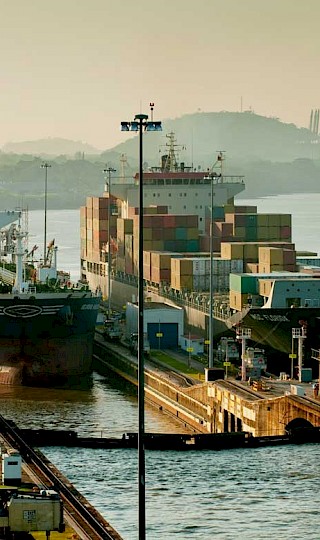
Arguably the most famous attraction in Panama is the Panama Canal. As one of the 7 Wonders of the Modern World, the Panama Canal is a must-see for anyone traveling in the country. Built to dramatically decrease the travel time for ships between the Pacific Ocean and Caribbean Sea, the Canal has seen over 900,000 vessels and counting. At one point this engineering miracle was considered impossible to build, but today, you can see it for yourself.
Did you know that the The Canal uses a lock system to lift ships up 85 feet to the elevation of the canal? How about the fact that it takes 8-10 hours for each ship to make the transit through the canal? Learn about all of this and more at the visitor center at Miraflores, where you can watch an IMAX documentary of the history of the canal narrated by Morgan Freeman. At Miraflores, you’ll also be able to watch the ships in transit just a few meters away.
For another vantage point, visit the Agua Clara Visitor’s Center on the Atlantic side of the Canal in Colón. Here, you’ll be able to see both the ships and the canal. Agua Clara is also where the brand new, larger locks are housed. Consider making a day of it, by canoeing The Chagres river afterwards, where you can visit the indigenous Emberá community in the Panama Canal watershed. Want the full Canal experience? While in Panama City, you can even organize a crossing of the Canal as a day trip to see the locks from a new perspective.



